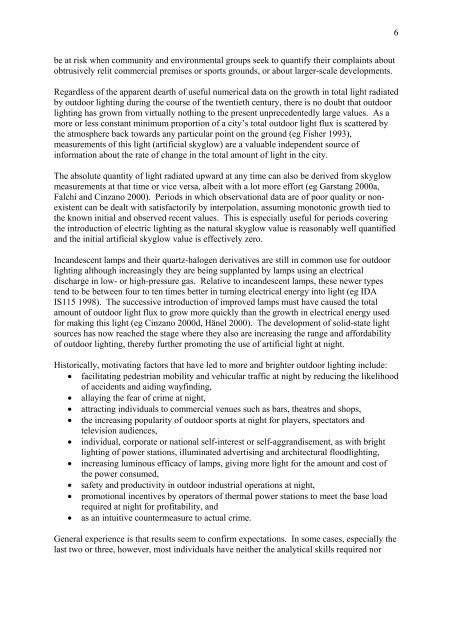Outdoor Lighting and Crime - Amper
Outdoor Lighting and Crime - Amper
Outdoor Lighting and Crime - Amper
You also want an ePaper? Increase the reach of your titles
YUMPU automatically turns print PDFs into web optimized ePapers that Google loves.
e at risk when community <strong>and</strong> environmental groups seek to quantify their complaints about<br />
obtrusively relit commercial premises or sports grounds, or about larger-scale developments.<br />
Regardless of the apparent dearth of useful numerical data on the growth in total light radiated<br />
by outdoor lighting during the course of the twentieth century, there is no doubt that outdoor<br />
lighting has grown from virtually nothing to the present unprecedentedly large values. As a<br />
more or less constant minimum proportion of a city’s total outdoor light flux is scattered by<br />
the atmosphere back towards any particular point on the ground (eg Fisher 1993),<br />
measurements of this light (artificial skyglow) are a valuable independent source of<br />
information about the rate of change in the total amount of light in the city.<br />
The absolute quantity of light radiated upward at any time can also be derived from skyglow<br />
measurements at that time or vice versa, albeit with a lot more effort (eg Garstang 2000a,<br />
Falchi <strong>and</strong> Cinzano 2000). Periods in which observational data are of poor quality or nonexistent<br />
can be dealt with satisfactorily by interpolation, assuming monotonic growth tied to<br />
the known initial <strong>and</strong> observed recent values. This is especially useful for periods covering<br />
the introduction of electric lighting as the natural skyglow value is reasonably well quantified<br />
<strong>and</strong> the initial artificial skyglow value is effectively zero.<br />
Inc<strong>and</strong>escent lamps <strong>and</strong> their quartz-halogen derivatives are still in common use for outdoor<br />
lighting although increasingly they are being supplanted by lamps using an electrical<br />
discharge in low- or high-pressure gas. Relative to inc<strong>and</strong>escent lamps, these newer types<br />
tend to be between four to ten times better in turning electrical energy into light (eg IDA<br />
IS115 1998). The successive introduction of improved lamps must have caused the total<br />
amount of outdoor light flux to grow more quickly than the growth in electrical energy used<br />
for making this light (eg Cinzano 2000d, Hänel 2000). The development of solid-state light<br />
sources has now reached the stage where they also are increasing the range <strong>and</strong> affordability<br />
of outdoor lighting, thereby further promoting the use of artificial light at night.<br />
Historically, motivating factors that have led to more <strong>and</strong> brighter outdoor lighting include:<br />
• facilitating pedestrian mobility <strong>and</strong> vehicular traffic at night by reducing the likelihood<br />
of accidents <strong>and</strong> aiding wayfinding,<br />
• allaying the fear of crime at night,<br />
• attracting individuals to commercial venues such as bars, theatres <strong>and</strong> shops,<br />
• the increasing popularity of outdoor sports at night for players, spectators <strong>and</strong><br />
television audiences,<br />
• individual, corporate or national self-interest or self-aggr<strong>and</strong>isement, as with bright<br />
lighting of power stations, illuminated advertising <strong>and</strong> architectural floodlighting,<br />
• increasing luminous efficacy of lamps, giving more light for the amount <strong>and</strong> cost of<br />
the power consumed,<br />
• safety <strong>and</strong> productivity in outdoor industrial operations at night,<br />
• promotional incentives by operators of thermal power stations to meet the base load<br />
required at night for profitability, <strong>and</strong><br />
• as an intuitive countermeasure to actual crime.<br />
General experience is that results seem to confirm expectations. In some cases, especially the<br />
last two or three, however, most individuals have neither the analytical skills required nor<br />
6
















